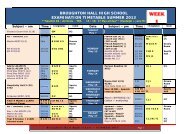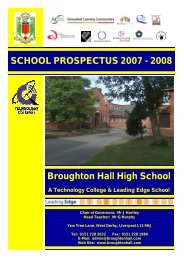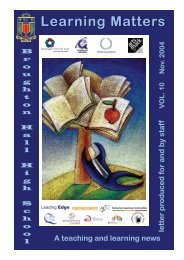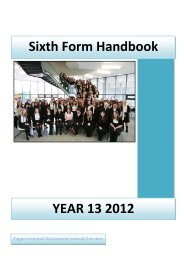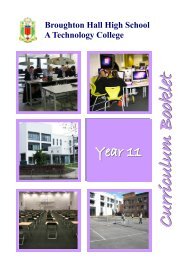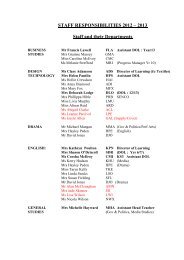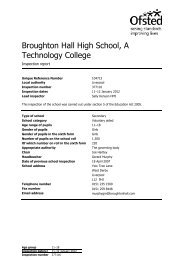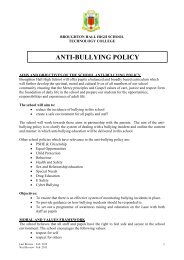WHOLE SCHOOL MARKING POLICY - Broughton Hall High School
WHOLE SCHOOL MARKING POLICY - Broughton Hall High School
WHOLE SCHOOL MARKING POLICY - Broughton Hall High School
You also want an ePaper? Increase the reach of your titles
YUMPU automatically turns print PDFs into web optimized ePapers that Google loves.
BROUGHTON HALL HIGH <strong>SCHOOL</strong><br />
<strong>WHOLE</strong> <strong>SCHOOL</strong> <strong>MARKING</strong> <strong>POLICY</strong><br />
Principles<br />
“Assessment for learning (AFL) is the process of seeking and interpreting evidence for use by students<br />
and their teachers, to decide where students are in their learning, where they need to go and how best<br />
to get there.”<br />
Marking and feedback at <strong>Broughton</strong> <strong>Hall</strong> will be consistent with the principles of Assessment for<br />
Learning (AfL), being:<br />
<br />
<br />
<br />
<br />
<br />
<br />
<br />
<br />
<br />
Informing future planning and thereby support individual ‘target getting’<br />
Focused on pupil learning<br />
Based on shared learning objectives<br />
Given at frequent intervals and following the appropriate timings<br />
Positive and personal in tone and accessible by all pupils<br />
Supportive of achievement in all its forms<br />
Helping pupils to improve their work<br />
Promoting learner confidence<br />
Including opportunities to develop peer and self‐assessment skills<br />
Strategies<br />
To plan for good learning teachers need to be aware of areas of weakness in pupil learning, as well as<br />
what pupils already know and understand. The identification of curricular targets and base lining<br />
supports this.<br />
<br />
<br />
Curricular targets – identified from a range of sources, curriculum targets identify typical areas<br />
of weakness in pupils’ learning, and become a focus for improvement.<br />
Base lining – at the start of a new unit of work teachers should ascertain what pupils<br />
specifically already know and understand. This should not just be a summative judgement such<br />
as a level, though this is important, but specific topics and skills which students have not yet<br />
grasped.<br />
This knowledge will inform the identification of curricular targets and objectives for whole year<br />
groups, classes, sets and individuals. More specifically it will inform the planning of learning objectives<br />
and learning outcomes by teachers.<br />
Within our lessons<br />
To support learning pupils need to know in advance what they are learning, what they will be expected<br />
to do and how their work will be marked. The use of learning objectives/outcomes and the sharing of<br />
success criteria support this.<br />
Learning objectives – broad learning objectives will be shared with pupils. These will focus on<br />
the learning e.g., on what pupils “will know” and “be able to do …” by the end of the learning<br />
June 2012<br />
Next Review : June 2014 Page 1
process. They will be expressed in such a way that they are accessible to all and could be<br />
summed up as “We are learning to…” (WALT).<br />
Learning outcomes – will also be shared. These will focus on what the pupils will be doing,<br />
making or producing, this might usefully be summed up as “What I am looking for… “(WILF).<br />
Objectives and outcomes may also be combined e.g. “We are learning to….. by……”<br />
Success criteria – the marking criteria against which different pieces of work will be marked<br />
should be shared e.g. in support of peer/self‐assessment, milestone pieces of work and/or end<br />
of unit assessments. These criteria may be generated in conjunction with the pupils or by the<br />
teacher/department as appropriate.<br />
Learning milestones – not all marking can or should be marked in detail. Within each unit of work<br />
departments will identify a finite number of key pieces of work for more in depth, quality marking. The<br />
frequency of these in depth marked pieces of work is related to the number of lessons that are taught<br />
in a given week.<br />
<br />
<br />
<br />
<br />
<br />
A minimum of six such pieces will be identified by foundation subjects over the course of a<br />
year, though core subjects will need to identify additional opportunities for quality marking to<br />
take place as they will need to mark two per half term.<br />
These pieces of work will focus on the assessment of progress in relation to specific learning<br />
objectives or if required curricular target/s.<br />
Success criteria will be shared with pupils and at the end of the marking process it should be<br />
clear to the pupil “what they have done well” and “what they need to do to improve”.<br />
Comments will be positive and subject specific. Linking words such as BUT are best avoided.<br />
“Even better if…” (EBI), may be a more helpful way of focusing teacher and pupil feedback.<br />
An interim KS level or grade will be awarded and pupils will be given the opportunity to<br />
improve their work. (Note in Mathematics, English and Science the NC level is only required<br />
on six of the twelve pieces marked.)<br />
Light touch/“tick and flick” marking –to support the giving of quality feedback at key points in the<br />
learning process, other work should be marked in less detail. Light touch marking will develop the skills<br />
of peer and self‐assessment, and will stand alongside whole class and teacher led marking of more<br />
closed tasks, class notes and exercises. Teachers will acknowledge and personalise such work<br />
variously through oral feedback as well as the use of an effort grade, ticks, simple marks (10/10),<br />
stickers, initials, and/or brief attainment based comments.<br />
Frequency of light touch/”tick and flick” marking – In order to ensure consistency across the school<br />
the following guidelines have been established as to the frequency of marking. The number of lessons<br />
refers to the class and not to the teacher. If a class is shared it is the responsibility of the two teachers<br />
to arrange a schedule that fulfils the frequency of marking requirements. Note the specific<br />
requirement detailed for Opening Minds at the end of this document.<br />
Three or more lessons per week – Books/Files/Portfolios marked twice every three weeks.<br />
Two lessons per week ‐ Books/Files/Portfolios marked each fortnight.<br />
One lesson per week ‐ Books/Files/Portfolios every three weeks.<br />
Formative marking – both the marking of milestone pieces and light touch marking are examples of<br />
formative marking. They inform the teacher and pupil of learning progress, identify the next steps and<br />
how they can best be taken. It informs teacher planning.<br />
Corrections – Ensuring pupils complete corrections or check through corrections made by the teacher<br />
when marking is an essential part of the learning process. Examples of corrections and improvements<br />
made should be seen through the students books/portfolios/files.<br />
June 2012<br />
Next Review : June 2014 Page 2
Other subject specific symbols may also be used and a copy of the Marking Template can be found in<br />
the shared area under Whole <strong>School</strong> Marking. Over correction is best avoided and in many subjects the<br />
spelling of subject specific words will be given greater priority.<br />
Attainment – Grades aren’t always necessary. They can for example be meaningless given the<br />
size/nature of the task, and distract from improvement comments. Grades can undermine confidence<br />
in some pupils and result in complacency for others. However, it is still important for teachers, parents<br />
and pupils to know periodically how well the learning is going and what still need to be done. Pupils<br />
need to be clear about what they need to do to progress from one level/grade to the next, and equally<br />
should be clear about the expected progress they should be making through the key stage. In order to<br />
support this process:<br />
<br />
<br />
<br />
levels and grades should be ‘translated’ into pupil speak and shared with pupils.<br />
key pieces of work or learning milestones, will be awarded an attainment grade expressed in<br />
terms of an interim KS level or grade.<br />
at the end of a unit a formal assessment will take place and a KS level or grade will be<br />
awarded.<br />
Effort – pupils of all ages and abilities say they like to see effort acknowledged. Effort though crucial for<br />
learning success, is distinct from attainment levels and is personal to the individual. Effort should be<br />
acknowledged by the awarding of an effort grade in line with whole school policy, descending from B<br />
at the top end of the scale to D at the bottom.<br />
Colour of Ink – having spoken to pupils there appears to be no concern about the use of red ink for<br />
marking; pupils instead expressed concern about over detailed marking which was seen as<br />
discouraging and “spoilt” presentation. RED ink or one that contrasts with that used by the pupil is<br />
therefore recommended.<br />
Effort:<br />
superB<br />
heading for sUccess<br />
promIsing<br />
beLow expectation<br />
Disappointing!<br />
towards success.<br />
Quality control – in order to ensure the consistent application of standards and to support the sharing<br />
of good practice departments will sample (e.g. a top, middle, bottom) milestones pieces and end of<br />
unit assessments for moderation. Time for this will be agreed by departments and may include<br />
department meetings, cluster meetings, Learning Review days or by accessing the directed time<br />
budget. Examples of standardised work should be retained and shared with pupils as part of the<br />
learning process, and can form part of the department’s marking evidence base for Ofsted.<br />
Tracking Pupil Progress – departments will retain centrally the levels/grades awarded to milestones<br />
pieces and in end of unit assessments. This may initially been kept as paper record but ultimately we<br />
will be moving towards a whole school on‐line record keeping system. Results should be traffic lighted<br />
in order to highlight pupils progressing below/in line/or above expectation. Consideration should then<br />
be given to the reasons for these variations. Action should be taken to formally recognise pupil<br />
success and share related good classroom practice, as well as to support underachievers and address<br />
areas of concern.<br />
June 2012<br />
Next Review : June 2014 Page 3
The Process<br />
Many parts of the process will be familiar even if you haven’t previously labelled them explicitly.<br />
Clearly objectives, outcomes and success criteria are central. Other steps will have varying degrees of<br />
emphasis according to the needs of pupils, time of the year and the professional judgement of<br />
teachers.<br />
Departments identify curricular targets<br />
Provide opportunities to apply criteria to previous work<br />
Provide guidance, support and oral feedback to individuals<br />
June 2012<br />
Next Review : June 2014 Page 4
June 2012<br />
Next Review : June 2014 Page 5




